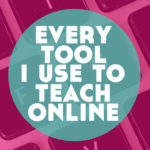August 20th, 2014
How to Teach on Skype: 12 Top Tips for Online Language Teachers
Teaching on Skype has quickly become a big part of my business. It’s a valuable part too – I can go from one lesson to another without the risk that’s always there with “real life” lessons of getting stuck in traffic. This means I can teach more. Instead of one lesson 3-4 then 4.15-5.15 then 5.45-6.45, I can work from 3 straight through to 6! Giving me an extra 45 minutes to catch up on some work, teach someone else, or even finish earlier! Woop! In this post I want to share how to teach on Skype.

With the likes of italki becoming bigger and more essential language learning resources by the day, teaching online is big business. Want to know how to teach on Skype? In this post, I’m going to share with you my 12 top tips for online language teachers to do just that.
1. Good equipment
It doesn’t matter if your laptop is old or your headset is your gaming one. The important thing is that your equipment works, and when I say equipment, that includes Internet connection. Likelihood is that your provider can’t always guarantee 100% perfect connection but make sure it’s as good as can be. You wouldn’t expect your mechanic to fix your car with a spanner from Poundland, would you? That said, I’m not trying to put you off! Go for it and make the best of what you have now to see if it’s right for you before investing big time.
As your business grows, so will your list of equipment you use to run it. This will begin to include digital tools such as Teachable, LeadPages and ConvertKit that have all been crucial to the growth of my online language teaching business.
If you’re curious about what tools to use to grow your own online language teaching business, this post sharing every tool I use to run my online language teaching business will save you hours and hours of research. Yay!
2. Good resources
When I started my business, one thing I was adamant about was making my own resources to set me apart from the competition. This is still something I do today. Having a good, solid base of teaching resources will make your job a lot easier.
Teaching online though also means you have to think outside the box a little bit – it’s no good having boxes of beautiful flashcards when your student can’t touch them! Focus your attention on Powerpoints, PDFs and Word documents – all things you can display and share easily with your online students. Check out my Pinterest page for some ideas.
3. Google Drive
My absolute essential for “real life” teaching is a whiteboard. Obviously, this is tricky to use via Skype.
As well as sharing presentations and documents with students in their private folder on my Google Drive, each student also gets their own Google Drawings document that we use as a whiteboard when necessary.
It’s also a great tool to play hangman, noughts and crosses (with a word in each square!) and other little word games with younger students to round off a great lesson.
4. Screen share
Not everyone knows this but Skype actually allows you to share your screen really easily. This is perfect for online tuition!
I’ve already mentioned sharing your presentations and other resources with students in their folder, but if they’re not logged in to the right Google account, it might just be easier to share your screen with them.
Not only that but screen share is great for sharing websites in other languages and explaining the tech side of things from time to time.
It’s really simple to do, when you’re in a call on Skype, just click the + button below the video of who you’re speaking with and the option will be there.
5. Always keep moving forward
Once you’ve found something that works, don’t sit still! Constantly look for ways to improve your teaching, keep making resources as well as updating the ones you already have.
I think the best way to do this is to keep learning languages yourself so that you know what the hottest new language app is that you can recommend to your students. Of course, you could have someone else do that bit for you (aka me!) and bookmark this blog for updates.
On the business side of things, one thing I recommend is dedicating at least an hour of your working week to learning and growing. Whether that’s online courses you’re studying or blog posts or videos that you’ve saved to read/watch later, it’s always worth investing some time in learning to improve your business and keep evolving.
If the thing that stumps you is how to promote and market your online teaching business, the Online Teaching Marketing Masterclass could be just what you’re looking for. Click here to read more and enroll to help you to keep moving forward.
6. Treat your students well
Consider your students as your employer as well as your customer, after all, they are the ones paying you and without them, you have no job. Make each student feel special by remembering what they like, what they don’t like, what they’re good at and what they’re not so good at. If it helps, you could use a little notebook to keep track. Of course resources can be reused for different students, but from time to time, I love making resources with specific students in mind!
Not only that but it’s also crucial to keep a good record of what you study with your students to make sure you’re staying up to date with their progress and your finances.
7. Calculate a fair price
I definitely advise getting started teaching online by experimenting with existing platforms such as italki and seeing how things go and if it’s something you want to pursue before you go ahead and invest time, effort, and money in things like your own website and email list.
However, relying on tutor ‘marketplaces’ alone will not give you a stable income and isn’t what I recommend when it comes to building a sustainable online teaching business.
So how can you calculate a fair price when you go it alone? Read this post to learn just that.
8. Mix your media
There’s so much stuff out there that it seems a shame to constantly give students the same source to work with. Use videos, audio and articles as stimuli for conversation.
Podcasts, news, YouTube, social media…Whatever you use, focus on real examples of the language and keep it fun and interesting! Sending these before the lesson will not only make you a keen and professional teacher but also give your students a chance to prepare any questions beforehand.
I’ve written about using Facebook, Pinterest, Snapchat and Instagram for language learning. These might be useful to give you some ‘out-of-the-box’ ideas for lessons. It doesn’t have to be all textbook!
9. Use what you have
It may be that you’re already teaching in real life in some capacity, in which case, awesome! You probably already have plenty of things that can be used when you’re teaching online. This will help to make the transition to online teaching much easier.
Chances are you won’t be starting from scratch, but that doesn’t mean that transferring your teaching online will just happen effortlessly. This post will help you to transfer your language teaching online.
10. Promote yourself
When you’re all set up and ready to go, you can begin to promote your services. Don’t do it until you’re ready – there’s no rush!
Social media, blogs, italki…basically the Internet! One of the joys of teaching online is that you can offer your services to anyone anywhere.
Don’t waste your time or money pushing leaflets through doors or paying for an ad in the local paper. Look wider. Be nice. Sell yourself.
If you’re looking for ways to promote yourself online, here are 3 big ways to get started. And if you’re ready to take it further, the Online Teaching Marketing Masterclass is for you.
There’s lots about this in my course the Online Teaching Starter Kit. This course is released just a couple of times a year.
11. Find your niche
When you’re first getting started, it can often feel like there’s way too many people out there doing what you want to do. That’s why it’s so important that you spend some time finding your niche early on.
“But hey! I have no students! I can’t limit down who I’m appealing to right now!”
I get it. It sounds contradictory, right? But trust me, once you’re creating content and targeting a specific niche rather than just writing a blog post or making a video to promote yourself about absolutely anything, you’ll be reaching the right people.
If you’re looking to find your niche, this blog post will help you do just that.
12. Look after yourself
If you want to make this a big part of your income, then chances are you’ll be spending a lot more time online than you do now. You have to consider this. Plan in regular exercise and get yourself outside! If your work is being on the Internet talking to people then playing your Xbox will have no positive relaxing effect. It’s just the same.
Related: Nailing Time Management + The Simple No-Tech Habit I Use Every Week for Better Time Management for Language Learning







